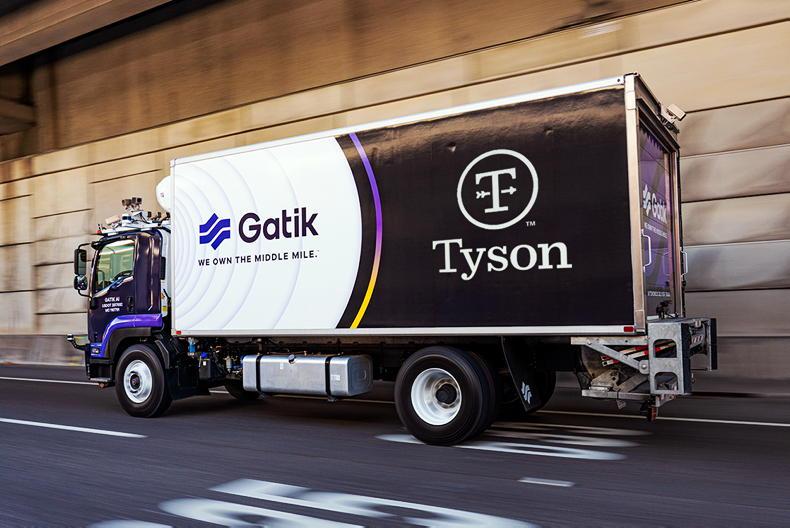Factory cattle prices in the US have been close to or above the equivalent of €6/kg for most of the past year, driven by scarcity of cattle supply as opposed to strong beef market performance.
This is reflected by recent USDA data, which shows that the national cattle herd has fallen to 87.2 million head – the lowest since 1951!
As a result, beef factories have been stretching beyond their comfort zone when buying cattle, and this has been reflected in the bottom line of company accounts.
Tyson Foods
The most recent insight we have into factory performance comes from Tyson Foods, who released their first-quarter results for the current financial year this week.
Across their entire business, which processes beef, poultry and pork, they posted an operating profit of $231m (€214m) on $13.3bn (€12.3bn) total sales for the three months ending 31 December 2023.
Beef processing is the largest part of the business, accounting for just over $5bn (€4.6bn) of the total sales, and it was also the worst performer.
Despite getting 10.5% more for the beef they sold, Tyson recorded an operating loss of $206m (€191m) in the first quarter. This compares with a small $166m (€154m) profit recorded in the same quarter last year, a 3.5% operating margin compared with a 4.1% loss this year.
The scarcity of cattle supplies is reflected in the 4.1% drop in volumes of beef processed in the first quarter compared with the same period last year.
Outlook
Tyson expects their beef business to perform poorly for the remainder of the financial year.
They refer to USDA forecasts of 2% less beef production for the remainder of this year, and their guidance on profitability is an operating income of at best break even, and a worst-case scenario of $400m (€370m) losses for the full year.
Overall, the company expects that operating income for the year will be in the range of $1bn to $1.5bn (€900m to €1.38bn), with their prepared foods division the big contributor at between $800m (€740m) and $1bn (€900m).
Chicken processing is forecast to contribute between $500m (€463m) and $700m (€648m), with pig meat operating income somewhere between break even and $100m (€92.5m).
Tyson Foods has capacity to process 155,000 cattle per week, and in the 2022 financial year, this was operating at 79% of capacity.
This adds up to approximately six million head of cattle processed annually, over three times more than the entire Irish annual cattle kill.

Scarcity of supply, not market strength, is the driver behind US cattle prices
Their poultry business has the capacity to process 47 million birds weekly, while their pig processing business has capacity for 471,000 pigs on a weekly basis.
On 1 October 2022, the company employed 142,000 people and their overall sales are split 44% to the retail sector, 29% to food service, 15% exported and 12% through other channels.
Tyson is the largest beef processor in the US and along with JBS, Cargill and the Marfrig controlled National Beef, account for 85% of beef processing in the US.
Relevance to Irish farmers
Irish farmers don’t have the opportunity to export cattle to the US for slaughter, so even if it was economically viable, it could be argued that US factory performance or even US prices are of little direct relevance.
However, what is of interest is the ability to learn through a quarterly update how one of the world’s largest meat processors is performing, and the extent to which their bottom line is shaped by the price they pay for cattle.
Figure 1 shows that over the past year, prices paid to farmers in the US have been far ahead of what Irish farmers received. Furthermore, the US price is paid on the basis of killout percentage averaging around 60% of live weight, as the dressing specification is more generous than it is in Ireland.
With US beef exports in the year to November 2023 dropping 17% by value and 13% by volume from a year earlier, it is clear that it is the scarcity of cattle supply that is the main driver of farmgate prices and the weak performance of Tyson’s beef division in the first quarter.
This situation is expected to prevail for the rest of the financial year, with break even position for beef their most optimistic forecast.
Work for Agri-Food Regulator
Of course, this is only part of the insight that US beef producers have into the processing sector, with USDA publishing real time data on sales and stocks volumes and values. When this is added to published company performance, farmers have a real insight to what value is added beyond the farm gate.
Irish beef producers don’t have anywhere near this level of insight. Only a couple of the smaller processors publish annual accounts and even these give a very limited insight.
Farmers will be hoping that the Agrifood regulators office has spent some time studying the US model of reporting and will look forward to steps being taken to create something that gives ideally the same level of insight in Ireland or at a minimum putting something in place where nothing exists at the moment.
Global meat prices
The United Nations updated its food price index for January and the trend it shows in meat prices could be a cause for concern. The level for the meat price index dropped to 109.8 in the first month of 2024, making a seventh consecutive monthly decline.
It is also the first time the index dropped below 110 since May 2021.
The drop in the index has largely been driven by ample supply in poultry, and increased national pig production in China coupled with plentiful international pork supply.
World beef prices fell marginally in January, which the United Nations said was “primarily reflecting high export supplies from South America and Oceania”.
The threat to global beef prices from Brazil and Australia is nothing new.
However, given the threat from recent – and proposed – trade deals, it could become a greater factor for Irish prices over the coming years.
Factory cattle prices in the US have been close to or above the equivalent of €6/kg for most of the past year, driven by scarcity of cattle supply as opposed to strong beef market performance.
This is reflected by recent USDA data, which shows that the national cattle herd has fallen to 87.2 million head – the lowest since 1951!
As a result, beef factories have been stretching beyond their comfort zone when buying cattle, and this has been reflected in the bottom line of company accounts.
Tyson Foods
The most recent insight we have into factory performance comes from Tyson Foods, who released their first-quarter results for the current financial year this week.
Across their entire business, which processes beef, poultry and pork, they posted an operating profit of $231m (€214m) on $13.3bn (€12.3bn) total sales for the three months ending 31 December 2023.
Beef processing is the largest part of the business, accounting for just over $5bn (€4.6bn) of the total sales, and it was also the worst performer.
Despite getting 10.5% more for the beef they sold, Tyson recorded an operating loss of $206m (€191m) in the first quarter. This compares with a small $166m (€154m) profit recorded in the same quarter last year, a 3.5% operating margin compared with a 4.1% loss this year.
The scarcity of cattle supplies is reflected in the 4.1% drop in volumes of beef processed in the first quarter compared with the same period last year.
Outlook
Tyson expects their beef business to perform poorly for the remainder of the financial year.
They refer to USDA forecasts of 2% less beef production for the remainder of this year, and their guidance on profitability is an operating income of at best break even, and a worst-case scenario of $400m (€370m) losses for the full year.
Overall, the company expects that operating income for the year will be in the range of $1bn to $1.5bn (€900m to €1.38bn), with their prepared foods division the big contributor at between $800m (€740m) and $1bn (€900m).
Chicken processing is forecast to contribute between $500m (€463m) and $700m (€648m), with pig meat operating income somewhere between break even and $100m (€92.5m).
Tyson Foods has capacity to process 155,000 cattle per week, and in the 2022 financial year, this was operating at 79% of capacity.
This adds up to approximately six million head of cattle processed annually, over three times more than the entire Irish annual cattle kill.

Scarcity of supply, not market strength, is the driver behind US cattle prices
Their poultry business has the capacity to process 47 million birds weekly, while their pig processing business has capacity for 471,000 pigs on a weekly basis.
On 1 October 2022, the company employed 142,000 people and their overall sales are split 44% to the retail sector, 29% to food service, 15% exported and 12% through other channels.
Tyson is the largest beef processor in the US and along with JBS, Cargill and the Marfrig controlled National Beef, account for 85% of beef processing in the US.
Relevance to Irish farmers
Irish farmers don’t have the opportunity to export cattle to the US for slaughter, so even if it was economically viable, it could be argued that US factory performance or even US prices are of little direct relevance.
However, what is of interest is the ability to learn through a quarterly update how one of the world’s largest meat processors is performing, and the extent to which their bottom line is shaped by the price they pay for cattle.
Figure 1 shows that over the past year, prices paid to farmers in the US have been far ahead of what Irish farmers received. Furthermore, the US price is paid on the basis of killout percentage averaging around 60% of live weight, as the dressing specification is more generous than it is in Ireland.
With US beef exports in the year to November 2023 dropping 17% by value and 13% by volume from a year earlier, it is clear that it is the scarcity of cattle supply that is the main driver of farmgate prices and the weak performance of Tyson’s beef division in the first quarter.
This situation is expected to prevail for the rest of the financial year, with break even position for beef their most optimistic forecast.
Work for Agri-Food Regulator
Of course, this is only part of the insight that US beef producers have into the processing sector, with USDA publishing real time data on sales and stocks volumes and values. When this is added to published company performance, farmers have a real insight to what value is added beyond the farm gate.
Irish beef producers don’t have anywhere near this level of insight. Only a couple of the smaller processors publish annual accounts and even these give a very limited insight.
Farmers will be hoping that the Agrifood regulators office has spent some time studying the US model of reporting and will look forward to steps being taken to create something that gives ideally the same level of insight in Ireland or at a minimum putting something in place where nothing exists at the moment.
Global meat prices
The United Nations updated its food price index for January and the trend it shows in meat prices could be a cause for concern. The level for the meat price index dropped to 109.8 in the first month of 2024, making a seventh consecutive monthly decline.
It is also the first time the index dropped below 110 since May 2021.
The drop in the index has largely been driven by ample supply in poultry, and increased national pig production in China coupled with plentiful international pork supply.
World beef prices fell marginally in January, which the United Nations said was “primarily reflecting high export supplies from South America and Oceania”.
The threat to global beef prices from Brazil and Australia is nothing new.
However, given the threat from recent – and proposed – trade deals, it could become a greater factor for Irish prices over the coming years.











SHARING OPTIONS